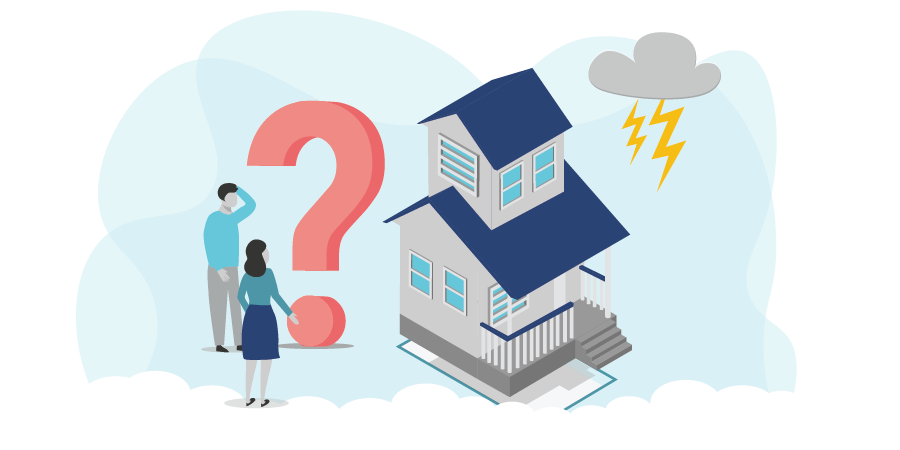The Biggest Insurance Mistake Homeowners Make
November 5, 2020
What’s worse than having a burst pipe flood your kitchen or a snowstorm damage your roof? Not having enough insurance to cover the full cost of a rebuild.
Getting the right coverage can be tricky. Too high and you’re overpaying for protections you don’t need. Too low and you risk serious financial hardship in the event of theft, a disaster, or some other nightmarish scenario.

How do you find that perfect Goldilocks number and get it “just right”? How do you know how much to insure your home for? And above all, how can you avoid being underinsured? Keep reading to find out.
How much should I insure for?
Your insurance coverage doesn’t need to equal what you paid for your house. Why? Because the actual cost of replacing your home after a loss isn’t the same as its original price—or even its current market value. Confused? Here’s the difference:
Actual Cash Value (ACV):
Also known as the resale or market value, actual cash value refers to how much your home is worth in today’s real estate market AFTER depreciation. The ACV also accounts for various external factors that have no direct correlation to reconstruction, like land value, location, and housing demand
Replacement Value
The cost to build a replica of your home from the ground up on its current property without deducting for depreciation, also known as the blanket amount. It includes everything from the price and availability of skilled labour to construction materials and building permits.
When selecting Property Insurance coverage, companies will generally offer you a choice between a policy based on your ACV or your Replacement Value.
So why shouldn’t I insure for my home’s ACV?
1. The Land Factor
Remember, the ACV factors in the value of your land and location. That means your home could overall be worth more simply because it’s sitting on a sizable chunk of land or located a real estate hotspot, even if you’ve made no other changes to the property. That sounds great in theory, right? After all, that is the goal of real estate: to sell your home for higher than you bought it and make some extra cash.
Here’s where it gets tricky: a high-value home needs higher limits of coverage, which in turn means a higher monthly premium. But in the event of a catastrophe, even if your home is destroyed, the land and location will most likely remain intact, or be unaffected altogether. So why pay more every month for something that can’t really be replaced?
Say your property has a big backyard, a huge front lawn, and some good schools nearby. You might be able to sell it for $800,000. But given the size and construction quality, the house itself may only take $500,000 to rebuild. Since you have a lower replacement value, it would be unwise to select an ACV policy. In this case, a replacement value policy will provide you with more than enough coverage to repair your home for a lower premium.
2. Depreciation
The main difference between the ACV and the replacement value is depreciation. No matter how much you paid for your home, an ACV policy will only provide you with enough insurance to cover your home’s current value.
But housing trends fluctuate. Maybe the market isn’t as hot. Or maybe your home is located in a storm-prone area. Or maybe there’s been a surge of crime in your neighbourhood. Either way, your home may have depreciated in value for factors beyond your control. And if you’ve selected an ACV policy, you’ll only have as much coverage as your home is worth today, even if it’s in pristine condition.
Here’s an example: A kitchen fire causes $30,000 worth of damage to your property. Due to the age of the home, the loss is depreciated at 40%. As a result, $12,000 will be deducted from the total cost of damage, leaving you with a payout of $18,000 from your insurance company. If you’re on an ACV policy, you’ll have to foot the remaining $12,000 out-of-pocket.
3. Home Improvement
While a good home reno can definitely add to your property’s value and appeal, the payoff doesn’t exactly line up with how much you spend renovating. Let’s put it this way: dropping $100,000 on a new kitchen and bathroom doesn’t mean your home’s ACV automatically goes up by an extra $100,000. Plus, if you’ve made substantial upgrades and neglected to tell your insurer, your policy won’t have enough coverage for an adequate reconstruction.
How do I get coverage that’s “just right”?
Follow these five tips to make sure you have just the right amount of coverage for your needs.
1. Know your home.
Be prepared to provide your insurance company with enough details for them to determine an accurate replacement cost, such as:
-
Year built;
-
Size and square footage (all finished areas, excluding basements);
-
Finished basement, garage, carport, or other structure attached to your home (including size and percentage finished);
-
Exterior and interior home features and building materials (foundation type, siding, windows, roof, wall finishes, ceiling, etc.);
-
Number of rooms, kitchens, and bathrooms and quality of finishes;
-
Fixtures, cabinets, flooring, and appliances;
-
Furniture and valuables;
-
And more.
Be sure to mention unique, custom, old, and/or hard-to-replace features, as well as the cost of inflation. You may need to pay extra to repair or replace anything that requires specialized craftsmanship.
2. Insure for your full replacement value—or a guaranteed replacement cost.
Although insurers only require you to insure a minimum of 80% of your home’s replacement value, it’s good idea to cover your home for the full cost of repairs. That way you’ll have enough to to completely rebuild or replace your property and/or belongings in the event of a disaster. It might cost a little bit more in monthly premiums, especially if you’ve made renovations, but it’ll help to restore your life with way less financial stress. If you only insure for 80%, you’ll still have to share the repair costs, which might easily add up to tens of thousands of dollars.
For more tips on how to buy Home Insurance, click here.
PRO Tips:
Your best bet is a guaranteed replacement cost policy. Here’s why: your replacement value is based on an estimate of your rebuild costs using construction materials of a similar price and quality. But what if that figure ends up being more than what you estimated? What if the cost of materials, excavation, or debris removal has skyrocketed since you last renewed or adjusted your policy? If so, you might have to cover the difference yourself.
In contrast, guaranteed replacement cost is just that—it’s guaranteed. Unlike a replacement value policy, it’s not subject to a maximum limit and ensures your home will be restored to its former glory no matter what unexpected hurdles pop up.
Here’s an example: if your replacement cost is estimated at $300,000 and the repairs cost $350,000, a guaranteed replacement cost policy will cover the full amount of the rebuild without you having to dip into your savings. However, you’ll be on your own if you decide to make any serious upgrades or major renovations, like finishing your basement or adding more living space to your home, without notifying your broker beforehand and updating your home policy.
3. Review your replacement costs.
We can’t stress this enough: review your costs. Home Insurance isn’t static. Your home, your property, and your lifestyle will evolve over time. And it’s important that your coverage reflects your changing needs.
Much like your insurance policy, you should review your replacement costs every few years—they’ll increase every time you make a major purchase, upgrade, or addition—and inform your insurer. New features add value. And unless you update your coverage, you risk having to pay for them again in the event of damage or destruction. Watch out for these key factors that’ll affect your replacement costs:
-
New building codes or permits that might require new safety features (usually for older homes);
-
Remodelled kitchens (e.g. quartz or granite countertops, stainless steel appliances);
-
Additional rooms and structures (e.g. refinished attic, new garage, workshop, or porch);
-
Custom features (cabinetry, moulding, designs, plaster work, etc.);
-
The current price of building materials of the same or a similar quality and other construction costs (bricks, timber, stone, worker’s wages, etc.);
-
The cost of demolition, debris removal, and preparing the land to rebuild; and
-
Demand. Following a catastrophic event that affects many homes, like wildfire or a flood, low supply of skilled labour and building materials may result in higher construction costs.
If you’re worried about how your latest renovations will affect your premium, check out our 11 Cost Saving Tips for Home Insurance.
4. Cover ALL of your assets.
Core homeowners insurance includes coverage for: your dwelling and all attached structures, your contents, and personal liability for any accidents or unintentional harm caused to others.
Contents coverage insures your personal possessions up to a specific limit, with additional sub-limits that apply to specialty property. That means your policy might not cover exceptionally valuable items over a certain dollar amount, usually around $2,000 or more. And valuable items don’t just refer to fine art, furs, and antiques; they also include expensive jewelry and watches, designer clothes, musical instruments, electronics, and even state-of-the-art appliances.
Be sure to:
-
Thoroughly document the contents of your home room by room.
-
Include detailed descriptions of each item (dates purchased, model and serial numbers), photos and/or videos, and receipts and appraisals, especially for expensive items.
-
Store your records somewhere secure, such as in the cloud or on a USB drive kept in a safe.
-
Review your home inventory annually (around renewal time) or after making big purchases and notify your insurer if anything changes.
5. When in doubt, just ask.
With extreme weather events at an all-time high and more people spending time at home than ever before, it’s critical to make sure you’re properly insured. While it might be tempting to pick the cheaper policy and save some cash, keep in mind: your home is probably the biggest and most valuable investment of your life. If something goes wrong–if your home is left unprotected–your financial security could be in jeopardy.
But navigating costs, values, and insurers can be confusing and overwhelming. And with insurance rates on the rise, it’s never been harder to find a policy for the right price.
Don’t know where to start? Call your broker–that’s what we’re here for! Brokers like PROLINK can make all the difference where it matters most. We’ll help you assess your replacement cost, track your possessions, and personalize your coverage to your needs, your lifestyle, and your budget. No matter where you’re coming from, or how complex your needs are, you can trust PROLINK to guide you to the right coverage from the right insurer at the right price.
Connect with PROLINK to learn more today!
PROLINK’s blog posts are general in nature. They do not take into account your personal objectives or financial situation and are not a substitute for professional advice. The specific terms of your policy will always apply. We bear no responsibility for the accuracy, legality, or timeliness of any external content.




